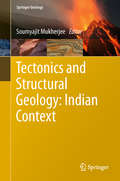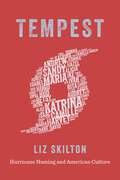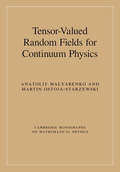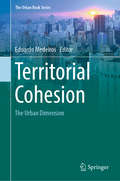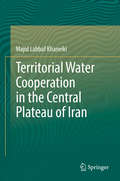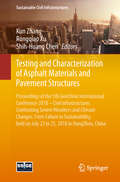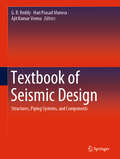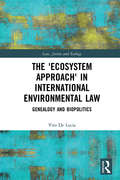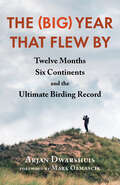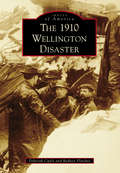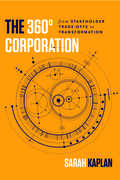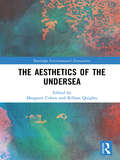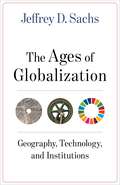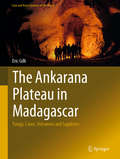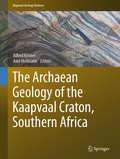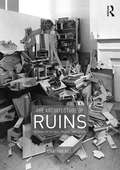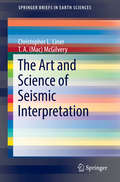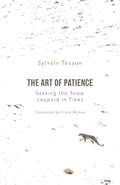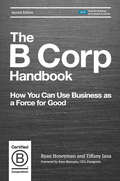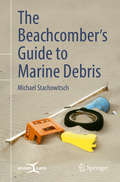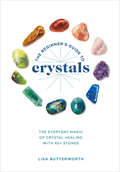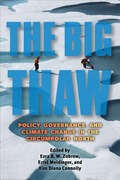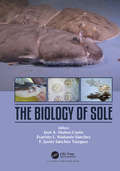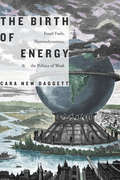- Table View
- List View
Tectonics and Structural Geology: Indian Context (Springer Geology)
by Soumyajit MukherjeeThis book presents a compilation of findings, review and original works, on the tectonic evolution and structural detail of several terrains in India. It captures the tectonic diversity of the Indian terrain, including tectonics of India's coastal areas, the tectonic evolution of Gondwana and Proterozoic (Purana) basins. It also describes the research results of the Indian craton's geo-history, Tertiary Bengal basin, and also the Himalayan collisional zone. Thus the book covers the deformation history of Indian terrain involving strike slip, compressional and extensional tectonics, and ductile and brittle shear deformations.
Tempest: Hurricane Naming and American Culture (The Natural World of the Gulf South)
by Liz SkiltonLiz Skilton’s innovative study tracks the naming of hurricanes over six decades, exploring the interplay between naming practice and wider American culture. In 1953, the U.S. Weather Bureau adopted female names to identify hurricanes and other tropical storms. Within two years, that convention came into question, and by 1978 a new system was introduced, including alternating male and female names in a pattern that continues today. In Tempest: Hurricane Naming and American Culture, Skilton blends gender studies with environmental history to analyze this often controversial tradition. Focusing on the Gulf South—the nation’s “hurricane coast”—Skilton closely examines select storms, including Betsy, Camille, Andrew, Katrina, and Harvey, while referencing dozens of others. Through print and online media sources, government reports, scientific data, and ephemera, she reveals how language and images portray hurricanes as gendered objects: masculine-named storms are generally characterized as stronger and more serious, while feminine-named storms are described as “unladylike” and in need of taming. Further, Skilton shows how the hypersexualized rhetoric surrounding Katrina and Sandy and the effeminate depictions of Georges represent evolving methods to define and explain extreme weather events. As she chronicles the evolution of gendered storm naming in the United States, Skilton delves into many other aspects of hurricane history. She describes attempts at scientific control of storms through hurricane seeding during the Cold War arms race of the 1950s and relates how Roxcy Bolton, a member of the National Organization for Women, led the crusade against feminizing hurricanes from her home in Miami near the National Hurricane Center in the 1970s. Skilton also discusses the skyrocketing interest in extreme weather events that accompanied the introduction of 24-hour news coverage of storms, as well as the impact of social media networks on Americans’ tracking and understanding of hurricanes and other disasters. The debate over hurricane naming continues, as Skilton demonstrates, and many Americans question the merit and purpose of the gendered naming system. What is clear is that hurricane names matter, and that they fundamentally shape our impressions of storms, for good and bad.
Tensor-Valued Random Fields for Continuum Physics (Cambridge Monographs on Mathematical Physics)
by Anatoliy Malyarenko Martin Ostoja-StarzewskiMany areas of continuum physics pose a challenge to physicists. What are the most general, admissible statistically homogeneous and isotropic tensor-valued random fields (TRFs)? Previously, only the TRFs of rank 0 were completely described. This book assembles a complete description of such fields in terms of one- and two-point correlation functions for tensors of ranks 1 through 4. Working from the standpoint of invariance of physical laws with respect to the choice of a coordinate system, spatial domain representations, as well as their wavenumber domain counterparts are rigorously given in full detail. The book also discusses, an introduction to a range of continuum theories requiring TRFs, an introduction to mathematical theories necessary for the description of homogeneous and isotropic TRFs, and a range of applications including a strategy for simulation of TRFs, ergodic TRFs, scaling laws of stochastic constitutive responses, and applications to stochastic partial differential equations. It is invaluable for mathematicians looking to solve problems of continuum physics, and for physicists aiming to enrich their knowledge of the relevant mathematical tools.
Territorial Cohesion: Cohesion, Development, Impact Assessment And Cooperation (Routledge Advances In European Politics Ser.)
by Eduardo MedeirosThis book offers a comprehensive overview of several urban related aspects that are of central importance to successful territorial cohesion processes. In essence, it sheds new light on issues concerning urban polycentrism, functional urban regions, integrated sustainable urban development, and the EU Urban Agenda; and on how they can help to achieve territorial cohesion policy goals. As an elusive and fairly recent concept, territorial cohesion has to date only been vaguely debated in the available literature, which for the most part focuses on its historical origins and its relevance for EU policymaking. Instead, this book synthesizes, for the first time, a range of perspectives that place urban elements and policies at the core of territorial cohesion analysis. As such, and given the fact that territorial cohesion is a holistic concept, the book will appeal to a broad readership from both the academic and policymaking arenas.
Territorial Water Cooperation in the Central Plateau of Iran
by Majid Labbaf KhaneikiThis book tries to answer the question how different communities in such an arid area as the Iranian central plateau could have shared their limited water resources in a perfect harmony and peace over the course of history. They invented some indigenous technologies as well as cooperative socio-economic systems in order to better adapt themselves to their harsh environment where the scarce water resources had to be rationed among the different communities as sustainably as possible. Those stories hold some lessons for us on how to adjust our needs to our geographical possibilities while living side by side with other people. This work gives insight into the indigenous adaptation strategies through the territorial water cooperation, and describes how water can appear as a ground for cooperation. It explains the water supply systems and social aspects of water in central Iran. Topics include the territorial water cooperation, qanat’s, the traditional water management and sustainability, the socio-economic context, the sustainable management of shared aquifers system and more.
Testing and Characterization of Asphalt Materials and Pavement Structures: Proceedings of the 5th GeoChina International Conference 2018 – Civil Infrastructures Confronting Severe Weathers and Climate Changes: From Failure to Sustainability, held on July 23 to 25, 2018 in HangZhou, China (Sustainable Civil Infrastructures)
by Kun Zhang Rongqiao Xu Shih-Huang ChenThis book presents new studies dealing with the attempts made by the scientists and practitioners to address contemporary issues in pavement engineering such as aging and modification of asphalt binders, performance evaluation of warm mix asphalt, and mechanical-based pavement structure analysis, etc.. Asphalt binder and mixture have been widely used to construct flexible pavements. Mechanical and Chemical characterizations of asphalt materials and integration of these properties into pavement structures and distresses analysis are of great importance to design a sustainable flexible pavement. This book includes discusses and new results dealing with these issues. Papers were selected from the 5th GeoChina International Conference 2018 – Civil Infrastructures Confronting Severe Weathers and Climate Changes: From Failure to Sustainability, held on July 23 to 25, 2018 in HangZhou, China.
Textbook of Seismic Design: Structures, Piping Systems, and Components
by Ajit Kumar Verma Hari Prasad Muruva G. R. ReddyThis book focuses on the seismic design of Structures, Piping Systems and Components (SSC). It explains the basic mechanisms of earthquakes, generation of design basis ground motion, and fundamentals of structural dynamics; further, it delves into geotechnical aspects related to the earthquake design, analysis of multi degree-of-freedom systems, and seismic design of RC structures and steel structures. The book discusses the design of components and piping systems located at the ground level as well as at different floor levels of the structure. It also covers anchorage design of component and piping system, and provides an introduction to retrofitting, seismic response control including seismic base isolation, and testing of SSCs. The book is written in an easy-to-understand way, with review questions, case studies and detailed examples on each topic. This educational approach makes the book useful in both classrooms and professional training courses for students, researchers, and professionals alike.
The 'Ecosystem Approach' in International Environmental Law: Genealogy and Biopolitics (Law, Justice and Ecology)
by Vito De LuciaThe ecosystem approach, broadly understood as a legal and governance strategy for integrated environmental and biodiversity management, has been adopted within a wide variety of international environmental legal regimes and provides a narrative, a policy approach and in some cases legally binding obligations for States to implement what has been called a ‘new paradigm’ of environmental management. In this last respect, the ecosystem approach is also often considered to offer an opportunity to move beyond the outdated anthropocentric framework underpinning much of international environmental law, thus helping re-think law in the Anthropocene. Against this background, this book addresses the question of whether the ecosystem approach represents a paradigm shift in international environmental law and governance, or whether it is in conceptual and operative continuity with legal modernity. This central question is explored through a combined genealogical and biopolitical framework, which reveals how the ecosystem approach is the result of multiple contingencies and contestations, and of the interplay of divergent and sometimes irreconcilable ideological projects. The ecosystem approach, this books shows, does not have a univocal identity, and must be understood as both signalling the potential for a decisive shift in the philosophical orientation of law and the operationalisation of a biopolitical framework of control that is in continuity with, and even intensifies, the eco-destructive tendencies of legal modernity. It is, however, in revealing this disjunction that the book opens up the possibility of moving beyond the already tired assessment of environmental law through the binary of anthropocentrism and ecocentrism.
The (Big) Year that Flew By: Twelve Months, Six Continents, and the Ultimate Birding Record
by Arjan Dwarshuis&“A fast-paced page-turner and a unique adventure story . . . filled with insights about landscapes, people, and a world of wonderful birds.&”―Kenn Kaufman, author of Kingbird HighwayAn epic tale of one passionate birder&’s record-breaking adventure through 40 countries over 6 continents—in just one year—to see 6,852 bird species, rare and common, before many go extinct.When Arjan Dwarshuis first heard of the &“Big Year&”—the legendary record for birdwatching—he was twenty years old, it was midnight, and he was sitting on the roof of a truck in the Andean Mountains. In that moment he promised himself that, someday, somehow, he would become a world-record-holding birder.Ten years later, he embarked on an incredible, arduous, and perilous journey that took him around the globe; over uninhabited islands, through dense unforgiving rainforests, across snowy mountain peaks and unrelenting deserts—in just a single year. Would he survive? Would he be able to break the &“Big Year&” record, navigating through a world filled with shifting climate and geopolitical challenges?The (Big) Year that Flew By is an unforgettable, personal exploration of the limits of human potential when engaging with the natural world. It is a book about birds and birding and Arjan&’s attempts to raise awareness for critically endangered species, but it is also a book about overcoming mental challenges, extreme physical danger, and human competition and fully realizing your passions through nature, adventure, and conservation.&“Dwarshius&’ exhilarating race against time across 40 countries and 6 continents in his attempt to break the world record will thrill armchair readers and bird enthusiasts alike.&”―Booklist&“I sped through [this] book, trying to ignore feelings of jealousy as Dwarshuis described moments with species I&’ve dreamed of seeing.&”—The Washington Post
The 1910 Wellington Disaster (Images of America)
by Deborah Cuyle Rodney FletcherThe town of Wellington was located by the Stevens Pass summit in the Cascade Mountains. During the last days of February in 1910, the snow was relentless in the Cascades, falling as much as one foot per hour and rising up to 20 feet deep in areas. Rotary plows could not keep the lines open as snow covered the railroad tracks almost immediately after being cleared. The Seattle Express, coming from Spokane, and a fast mail train were stranded just beyond the "safety" of the Cascade Tunnel, where they remained unmovable for almost a week under the snowpacked mountains. On March 1, an avalanche swept away the tracks and passengers aboard the two trains as well as several of Wellington's buildings and homes. Almost 100 individuals were killed in just a few seconds, creating America's deadliest avalanche and train disaster in history. Today, the site is part of the Iron Goat Trail off Highway 2, east of Skykomish. The snowshed, the abandoned original Cascade Tunnel, and various scraps of the trains left in the ravine are the only evidence that remain of Wellington, its long-forgotten inhabitants, or the disaster.
The 360° Corporation: From Stakeholder Trade-offs to Transformation
by Sarah KaplanCompanies are increasingly facing intense pressures to address stakeholder demands from every direction: consumers want socially responsible products; employees want meaningful work; investors now screen on environmental, social, and governance criteria; "clicktivists" create social media storms over company missteps. CEOs now realize that their companies must be social as well as commercial actors, but stakeholder pressures often create trade-offs with demands to deliver financial performance to shareholders. How can companies respond while avoiding simple "greenwashing" or "pinkwashing"? This book lays out a roadmap for organizational leaders who have hit the limits of the supposed win-win of shared value to explore how companies can cope with real trade-offs, innovating around them or even thriving within them. Suggesting that the shared-value mindset may actually get in the way of progress, bestselling author Sarah Kaplan shows in The 360° Corporation how trade-offs, rather than being confusing or problematic, can actually be the source of organizational resilience and transformation.
The Aesthetics of the Undersea (Routledge Environmental Humanities)
by Margaret Cohen Killian QuigleyAmong global environments, the undersea is unique in the challenges it poses – and the opportunities it affords – for sensation, perception, inquiry, and fantasy. The Aesthetics of the Undersea draws case studies in such potencies from the subaqueous imaginings of Western culture, and from the undersea realities that have inspired them. The chapters explore aesthetic engagements with underwater worlds, and sustain a concern with submarine "sense," in several meanings of that word: when submerged, faculties and fantasies transform, confronting human subjects with their limitations while enlarging the apparent scope of possibility and invention. Terrestrially-established categories and contours shift, metamorphose, or fail altogether to apply. As ocean health acquires an increasing share of the global environmental imaginary, the histories of submarine sense manifest ever-greater importance, and offer resources for documentation as well as creativity. The chapters deal with the sensory, material, and formal provocations of the underwater environment, and consider the consequences of such provocations for aesthetic and epistemological paradigms. Contributors, who hail from the United States, United Kingdom and Australia, include scholars of literature, art, new media, music and history. Cases studies range from baroque and rococo fantasies to the gothic, surrealism, modernism, and contemporary installation art. By juxtaposing early modern and Enlightenment contexts with matters of more recent – and indeed contemporary – importance, The Aesthetics of the Undersea establishes crucial relations among temporally remote entities, which will resonate across the environmental humanities.
The Ages of Globalization: Geography, Technology, and Institutions
by Jeffrey D. SachsToday’s most urgent problems are fundamentally global. They require nothing less than concerted, planetwide action if we are to secure a long-term future. But humanity’s story has always been on a global scale. In this book, Jeffrey D. Sachs, renowned economist and expert on sustainable development, turns to world history to shed light on how we can meet the challenges and opportunities of the twenty-first century. <P><P>Sachs takes readers through a series of seven distinct waves of technological and institutional change, starting with the original settling of the planet by early modern humans through long-distance migration and ending with reflections on today’s globalization. Along the way, he considers how the interplay of geography, technology, and institutions influenced the Neolithic revolution; the role of the horse in the emergence of empires; the spread of large land-based empires in the classical age; the rise of global empires after the opening of sea routes from Europe to Asia and the Americas; and the industrial age. The dynamics of these past waves, Sachs demonstrates, offer fresh perspective on the ongoing processes taking place in our own time—a globalization based on digital technologies. Sachs emphasizes the need for new methods of international governance and cooperation to prevent conflicts and to achieve economic, social, and environmental objectives aligned with sustainable development. The Ages of Globalization is a vital book for all readers aiming to make sense of our rapidly changing world.
The Ankarana Plateau in Madagascar: Tsingy, Caves, Volcanoes and Sapphires (Cave and Karst Systems of the World)
by Eric GilliThe book describes the Ankarana plateau and its cave network in Madagascar, depicting the natural environment of the Plateau as well as the natural processes which created the cave network of more than 100km with many galleries, some are very large and draped with different cave formations and underground rivers are inhabited with crocodiles and giant eels.This place is famous for its surface landscape formed with tsingy, natural needles formed by the weathering of limestone. The Ankarana is surrounded by native Madagascan rain forest inhabited with lemurs and it was a natural shelter for the Ankarana people whose kings were buried in caves. The cave system has been partially explored since the sixties and exploration is still in progress. The book includes several maps (geology, topography, hydrology), the survey of the caves and a brief description of the Ankarana Kingdom.
The Archaean Geology of the Kaapvaal Craton, Southern Africa (Regional Geology Reviews)
by Alfred Kröner Axel HofmannThis book provides a comprehensive overview of the evolution of one of the oldest and best-exposed Archaean cratons on this planet. There is currently a renewed interest in the early Earth, and the Kaapvaal craton has long served as a model for early crustal evolution. This unique multidisciplinary resource features information on geology, tectonics, geochemistry, and geochronology. It offers a wealth of new data on various aspects of the craton as well as contributions on the various crustal units by international specialists.
The Architecture of Ruins: Designs on the Past, Present and Future
by Jonathan HillThe Architecture of Ruins: Designs on the Past, Present and Future identifies an alternative and significant history of architecture from the sixteenth century to the twenty-first century, in which a building is designed, occupied and imagined as a ruin. This design practice conceives a monument and a ruin as creative, interdependent and simultaneous themes within a single building dialectic, addressing temporal and environmental questions in poetic, psychological and practical terms, and stimulating questions of personal and national identity, nature and culture, weather and climate, permanence and impermanence and life and death. Conceiving a building as a dialogue between a monument and a ruin intensifies the already blurred relations between the unfinished and the ruined and envisages the past, the present and the future in a single architecture. Structured around a collection of biographies, this book conceives a monument and a ruin as metaphors for a life and means to negotiate between a self and a society. Emphasising the interconnections between designers and the particular ways in which later architects learned from earlier ones, the chapters investigate an evolving, interdisciplinary design practice to show the relevance of historical understanding to design. Like a history, a design is a reinterpretation of the past that is meaningful to the present. Equally, a design is equivalent to a fiction, convincing users to suspend disbelief. We expect a history or a novel to be written in words, but they can also be delineated in drawing, cast in concrete or seeded in soil. The architect is a ‘physical novelist’ as well as a ‘physical historian’. Like building sites, ruins are full of potential. In revealing not only what is lost, but also what is incomplete, a ruin suggests the future as well as the past. As a stimulus to the imagination, a ruin’s incomplete and broken forms expand architecture’s allegorical and metaphorical capacity, indicating that a building can remain unfinished, literally and in the imagination, focusing attention on the creativity of users as well as architects. Emphasising the symbiotic relations between nature and culture, a building designed, occupied and imagined as a ruin acknowledges the coproduction of multiple authors, whether human, non-human or atmospheric, and is an appropriate model for architecture in an era of increasing climate change.
The Art and Science of Seismic Interpretation (SpringerBriefs in Earth Sciences)
by Christopher L. Liner T. A. McGilveryThis book demystifies that art and science of seismic interpretation for those with and without formal geophysical training. From geologists to managers and investors, The Art and Science of Seismic Interpretation is a guide to what seismic data is, how it is interpreted, and what it can deliver.
The Art and Science of Seismic Interpretation (SpringerBriefs in Earth Sciences)
by Christopher L. Liner T. A. McGilveryThis book demystifies that art and science of seismic interpretation for those with and without formal geophysical training. From geologists to managers and investors, The Art and Science of Seismic Interpretation is a guide to what seismic data is, how it is interpreted, and what it can deliver.
The Art of Patience: Seeking the Snow Leopard in Tibet
by Sylvain TessonWinner of the Prix Renaudot 2019 A New York Times Best Book of 2021 &‘Extraordinarily beautiful… a long last loving glance at the planet.&’ Carl Safina, author of Becoming Wild The Art of Patience sees the renowned French adventurer and writer set off for the high plateaux of remotest Tibet in search of the elusive snow leopard. There, in the company of leading wildlife photographer Vincent Munier and two companions, at 5,000 metres and in temperatures of -25ºC, the team set up their hides on exposed mountainsides, and occasionally in the luxury of an icy cave, to await a visitation from the almost mythical beast. This tightly focused and tautly written narrative is simultaneously a dazzling account of an exacting journey, an apprenticeship in the art of patience, an acceptance of the ruthlessness of the natural world and, finally, a plea for ecological sanity. A small masterpiece, it is one of those books that demands to be read again and again.
The B Corp Handbook, Second Edition: How You Can Use Business as a Force for Good
by Ryan Honeyman Tiffany Jana"This book shows how using business as a force for good, not just pursuing short-term profits, can be better for consumers, employees, local communities, the environment, and your company's long-term bottom line."—Tony Hsieh, New York Times bestselling author of Delivering Happiness and CEO, Zappos.com, Inc. B Corps are a global movement of more than 2,700 companies in 60 countries—like Patagonia, Ben & Jerry's, Kickstarter, Danone North America, and Eileen Fisher—that are using the power of business as a force for good. B Corps have been certified to have met rigorous standards of social and environmental performance, accountability, and transparency. This book is the authoritative guide to the what, why, and how of B Corp certification.Coauthors Ryan Honeyman and Dr. Tiffany Jana spoke with the leaders of over 200 B Corps from around the world to get their insights on becoming a Certified B Corp, improving their social and environmental performance, and building a more inclusive economy. The second edition has been completely revised and updated to include a much stronger focus on diversity, equity, and inclusion (DEI). These changes are important because DEI can no longer be a side conversation—it must be a core value for any company that aspires to make money and make a difference.While this book is framed around the B Corp movement, any company, regardless of size, industry, or location, can use the tools contained here to learn how to build a better business. As the authors vividly demonstrate, using business as a force for good can help you attract and retain the best talent, distinguish your company in a crowded market, and increase trust in your brand.
The Beachcomber’s Guide to Marine Debris
by Michael StachowitschThis richly illustrated book serves as the ideal guide to the items that litter the world’s beaches. Forget sea shells and other fauna and flora. Here, you will find what a beachcomber is actually most likely to encounter these days: glass, plastic, wood, metal, paper, oil, and other sources of marine pollution!Complete with nearly 700 photographs, this guide shows the full range of marine debris items, each presented with insight and a pinch of humor. In addition, the author provides full details about these items. You will learn everything worth knowing about them. This includes not just their sources and decomposition stages. Discover the threat each item poses to these beautiful environments as well as prevention strategies, clean-up recommendations, alternative products, and recycling and upcycling ideas.Beyond the aesthetic issue, marine debris poses a threat to wildlife, human health, and economic welfare. This book arms you with the knowledge you need to combat these disgraceful and often hazardous eyesores. Become a beach detective! Travel the world’s most beloved tourist destinations with this ultimate beach read and help restore these fascinating environments to their natural beauty.
The Beginner's Guide to Crystals: The Everyday Magic of Crystal Healing, with 65+ Stones
by Lisa ButterworthFrom amethyst to zincite, black onyx to rose quartz, The Beginner's Guide to Crystals is a full-color, photographic guide to more than 60 stunning crystals and their emotional, spiritual, and physical healing benefits.The beauty and allure of these ancient stones are explored in this introductory guide to understanding crystals and their many uses. Harness the healing power of these minerals by using them as a talisman for protection, to manifest intentions, to bring calmness and tranquility, and to enhance concentration and creativity. Complete with clean, modern photographs of each mineral and stone, the crystal profiles contain accessible information on color, chakra, origin, unique magical healing qualities, and uses at work, at home, and in your personal life. With tips for building and maintaining a collection as well as performing crystal rituals for metaphysical healing, The Beginner's Guide to Crystals provides everything you need to experience the wide range of benefits these stones offer. Whether used to treat physical ailments like hypertension, high blood pressure, and circulatory issues, or to soothe emotional issues such as anxiety, fear, and stress, this guide will introduce you to the perfect crystal for bringing wellness and balance to your life.
The Big Thaw: Policy, Governance, and Climate Change in the Circumpolar North (SUNY series in Environmental Governance: Local-Regional-Global Interactions)
by Ezra B. W. Zubrow; Errol Meidinger; Kim Diana ConnollyClimate change, one of the drivers of global change, is controversial in political circles, but recognized in scientific ones as being of central importance today for the United States and the world. In The Big Thaw, the editors bring together experts, advocates, and academic professionals who address the serious issue of how climate change in the Circumpolar Arctic is affecting and will continue to affect environments, cultures, societies, and economies throughout the world. The contributors discuss a variety of topics, including anthropology, sociology, human geography, community economics, regional development and planning, and political science, as well as biogeophysical sciences such as ecology, human-environmental interactions, and climatology.This book is freely available in an open access edition thanks to Knowledge Unlatched—an initiative that provides libraries and institutions with a centralized platform to support OA collections and from leading publishing houses and OA initiatives. Learn more at the Knowledge Unlatched website at: https://www.knowledgeunlatched.org/, and access the book online at the SUNY Open Access Repository at http://hdl.handle.net/20.500.12648/7130.
The Biology of Sole
by José A. Munoz-Cueto Evaristo Mañanós-Sánchez F. Javier Sánchez-VázquezThis book reviews up-to-date knowledge on the biology of sole (Solea senegalensis and S. solea). These flatfish species are increasingly important in Europe both from the ecological and production point of view. This book is divided into two sections: A. general fisheries, aquaculture and engineering overviews; B. physiological, developmental, rhythmic, welfare and genetic aspects which will be of immense interest for the aquaculture industry. Experts, from both academia and research institutes, provide their expertise on sole biology.
The Birth of Energy: Fossil Fuels, Thermodynamics, and the Politics of Work (Elements)
by Cara New DaggettIn The Birth of Energy Cara New Daggett traces the genealogy of contemporary notions of energy back to the nineteenth-century science of thermodynamics to challenge the underlying logic that informs today's uses of energy. These early resource-based concepts of power first emerged during the Industrial Revolution and were tightly bound to Western capitalist domination and the politics of industrialized work. As Daggett shows, thermodynamics was deployed as an imperial science to govern fossil fuel use, labor, and colonial expansion, in part through a hierarchical ordering of humans and nonhumans. By systematically excavating the historical connection between energy and work, Daggett argues that only by transforming the politics of work—most notably, the veneration of waged work—will we be able to confront the Anthropocene's energy problem. Substituting one source of energy for another will not ensure a habitable planet; rather, the concepts of energy and work themselves must be decoupled.
